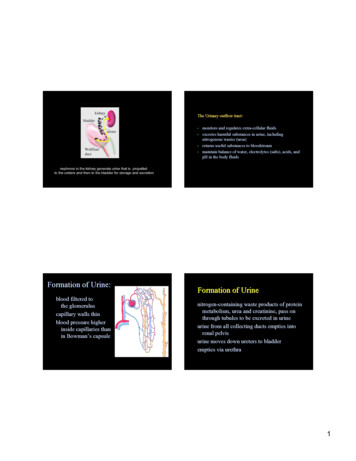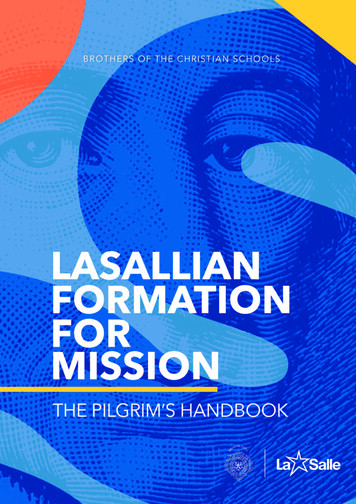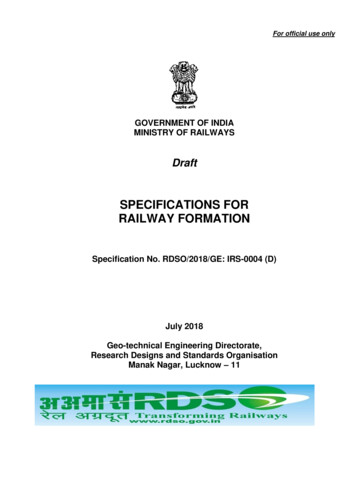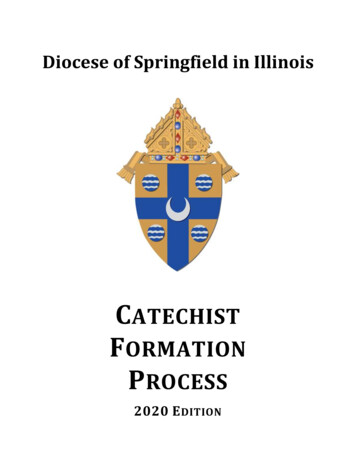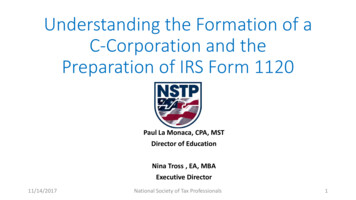
Transcription
Understanding the Formation of aC-Corporation and thePreparation of IRS Form 1120Paul La Monaca, CPA, MSTDirector of EducationNina Tross , EA, MBAExecutive Director11/14/2017National Society of Tax Professionals1
Formation of a Corporation A corporation is created as a result of State law Subjected to formal requirements of each State Ownership is witnessed through the issuance of stockcertificates to shareholders Shareholders have legal rights to the distribution ofcorporate profits Shareholders do not own the assets of the entity Observation of the formalities ensures that the entity istreated separately from the owners11/14/2017National Society of Tax Professionals2
§351 Formation of a Corporation §351 provides a general rule that the act ofincorporating is not a taxable event to the entity orthe shareholders, if 3 specific conditions are met:1. Shareholders transfer property to the corporation2. The transfer is solely in exchange for stock of thecorporation, and3. Immediately after the transfer, the transferors are incontrol of corporation11/14/2017National Society of Tax Professionals3
§351 Formation Issues In order to have control, the transferorsmust own: 80% of total combined voting power of allclasses of stock entitled to vote, plus 80% of total number of shares of all otherclasses of stock11/14/2017National Society of Tax Professionals4
§351 Corporate Formation Transaction11/14/2017National Society of Tax Professionals5
Required Attachments to Returns Both the corporation and each shareholder involved ina §351 transaction must attach to their tax returns, acomplete statement of all the facts pertinent to theexchange including: Property given up and receivedType of stock transferred and receivedNumber of shares involvedVoting vs. non-voting stockCommon vs. preferred stockPar Values, etc.11/14/2017National Society of Tax Professionals6
§351 Formation ExampleTaxpayer decided to incorporate a business:AssetTax BasisCash 10,000Furniture & Fixtures20,000Other Assets40,000Total 70,000Fair Mkt.Value 10,00060,000100,000 170,000 Without §351: gain of 100,000. With §351: no gain or loss. Economic status has not changed11/14/2017National Society of Tax Professionals7
Exceptions to Non-recognition There are 3 exceptions to the no gain or loss rule:1) Boot received exception2) Services exchanged exception3) Debt greater than basis exception Boot Exception: If property other than stock is received bythe shareholder then gain is recognized by theshareholder in an amount up to the lesser of: Boot received or Realized gain A loss is never recognized11/14/2017National Society of Tax Professionals8
Exceptions to Non-recognition Services Exception: if a shareholder receives stockin exchange for services provided to thecorporation then gain is recognized by theshareholder because “services” is not “property” If the other shareholders do not own 80% of theremaining stock then they will also have a recognitiontransaction, and gain or loss will be recognized by allparties involved in the exchange11/14/2017National Society of Tax Professionals9
Exceptions to Non-recognition Debt Greater Than Basis Exception: If ashareholder transfers property to the corporationin exchange for stock and there is debt attached tothe property which is greater than the adjustedbasis of the property given up then that individualshareholder will have gain recognition Debt Basis Gain11/14/2017National Society of Tax Professionals10
§351 Formation Issues Transfers for property and services: May result in the service provider being treated as amember of the 80% control group, but will be taxed onvalue of stock issued for services Not taxed on value of stock received for propertycontributed Service provider should transfer property having more than“a relatively small value”11/14/2017National Society of Tax Professionals11
Shareholder Stock Basis After §351 Exchange Shareholder’s basis of stock received in exchange forproperty given up:Adjusted basis of assets transferred to corporation Gain recognized on exchange by shareholder (if any)- Boot received- Liabilities transferred to corporation Basis of Stock Received by Shareholder11/14/2017National Society of Tax Professionals12
Corporation’s Basis in Assets ReceivedFrom Shareholder After §351 Exchange Corporation’s basis in assets received from theshareholder under §362:Adjusted basis of transferred assets by shareholder Gain recognized by shareholder (if any) §362 Basis of Assets to the Corporation11/14/2017National Society of Tax Professionals13
C Corporation Filing Requirements IRS Form 1120 “U.S. Corporation Income Tax Return” Must file Form 1120 if in existence on any day during the tax yeareven if corporation had no activity Due date: 15th day of 4th month after the close of the tax year Exception for C Corporations with a June 30 year end: 15thday of 3rd month until years ending after June 30, 2025 Automatic 5 month extension: file IRS Form 700411/14/2017National Society of Tax Professionals14
C Corporation Filing Requirements Penalty for late filing of tax return: 5%* per month,maximum 5 month period 25% *Note: Reduced by ½ of 1% for any month when there is also a “failure topay” penalty imposed, therefore nets to 4.5% for that month Penalty for late payment of tax: ½ of 1% per month fora maximum period of 50 months 25% Minimum penalty imposed for a return over 60 dayslate: smaller of the tax due or 205** ** indexed to inflation11/14/2017National Society of Tax Professionals15
§6655 Estimated Tax Payments Estimated payments required if corporate tax is 500 ormore If not paid then subjected to underpayment penalty forfailure to pay estimated taxes §6655(c) installment payments due by the 15th day ofthe 4th, 6th, 9th and 12th months of the tax year Next business day if Saturday, Sunday or legal holiday Calculate estimated payments on IRS Form 1120-W11/14/2017National Society of Tax Professionals16
§6655 Estimated Tax Payments Corporation must use Electronic Federal PaymentsSystem (EFTPS) to make installment payments Deposit on time: submit by 8:00 PM Eastern Time theday before the date the deposit is due Same-Day Wire Option: If corporation fails to submitvia EFTPS then the Federal Tax Collection Service (FTCS)is available These are third party financial institutions that have different cutoff times and charge a fee (www.irs.gov/payments) click on“Same-day-wire”11/14/2017National Society of Tax Professionals17
§6655(d) Required Installments Quarterly 25% deposits of the “required annualpayment” “Required annual payment” means the lesser of: 100% of the tax reported on the current year return, or 100% of the tax reported on the prior year’s return**The prior year test will not apply if the prior taxableyear was less than 12 months or no return was filed inthe prior year11/14/2017National Society of Tax Professionals18
§11(b)(1) Graduated Corporate Tax Rates 15% on first 50,000 of taxable income 25% on next 25,000 of taxable income 34% on next 25,000 of taxable income 39% on any amount in excess of 100,000 up to 335,000** Phases out the benefit of the 15% and 25% rateson the first 100,00011/14/2017National Society of Tax Professionals19
Flat Rate on Personal Service Corporations (PSC) §11(b)(2) provides an exception to graduated rates Certain PSC subjected to a flat 35% rate on each dollar of taxableincome if the trade or business is in the fields of: Health Law Engineering Architecture Accounting Performing arts Actuarial Sciences Consulting11/14/2017National Society of Tax Professionals20
Corporate Tax IssuesCorporate Transactions Corporate Revenue(Minus deductions) Net Profit(Minus Corp. Tax) Profits to Shareholders* *Dividend Distributions11/14/2017Shareholder Transactions Dividend from Corporationincluded in grossincome on Form 1040 Taxed as ordinaryincome Taxed at long-termcapital gain rates ifqualified dividendsNational Society of Tax Professionals21
Distributions to Shareholders Dividends to the extent of Earnings and Profits (E&P) of theC-Corporation Taxed at ordinary income rates unless qualified dividends, thentaxed at long-term capital gain rates Return of Invested Capital Any part of a corporate distribution not from E&P Reduces the adjusted basis of the shareholder’s stock and notincludible in the shareholder’s gross income Capital Gain Distributions not from E&P and more than the adjusted basis of theshareholder’s stock11/14/2017National Society of Tax Professionals22
Distributions to Shareholders Cash Dividends: declared by the Board of Directors toshareholders of record on a specified date Property Dividends: Distributions of corporate assetsresulting in a “deemed sale” at the corporate levelresulting in income to the corporation and a dividend tothe shareholder Constructive Dividends: (disguised dividends) favorabletreatment to shareholders made in a form other than,declared dividends and property dividends11/14/2017National Society of Tax Professionals23
Cash Dividend Corporation pays dividends in the formof money Dividends are not deductible expenseson the Form 112011/14/2017National Society of Tax Professionals24
Property Distribution FMV of corporate asset on the date of distribution (Less: Adjusted basis of the corporate asset) Equals: Gain at the Corporate Level* *Dividend to shareholder11/14/2017National Society of Tax Professionals25
Constructive Dividends Below-market Loans: Corporation gives shareholder loans at rates less thanthe “Applicable Federal Rate” (AFR) or at no rate at all Cancelled Debts: Corporation cancels shareholder debts for moneyborrowed from the corporation Transfer of property at less than FMV: sale of assets by corporation to shareholders at a pricebelow the market price11/14/2017National Society of Tax Professionals26
Constructive Dividends Unreasonable Rents: Corporation pays an amount for rent unreasonably greaterthan the going rate Unreasonable Salaries: Corporation compensates a shareholder-employee forservices provided at an unreasonably excessive amount toavoid the corporate level income tax Above-market Loans: Shareholders paid interest on loans to corporation at anunreasonably high rate11/14/2017National Society of Tax Professionals27
Special Issues Pertaining to Form 1120 Net Operating Losses: Locked in the entity level: automatic carryback of 2 yearswith an election to forego; carryforward 20 years Capital Losses: Locked in the entity level: automatic carryback of 3 years andcarryforward 5 years Charitable Contribution Deductions: Limited to 10% ofthe taxable income before the charitable contribution No carryback period allowed Limited 5 year carryforward only11/14/2017National Society of Tax Professionals28
Special Issues Pertaining to Form 1120 Schedule L*: Balance Sheet: Assets & Liabilities Schedule M-1*: Reconciliation of Income per Bookswith Income per Return: Items that have different treatment for book vs. tax Schedule M-2*: Analysis of Unappropriated RetainedEarnings per books: Amount available for distribution to shareholders per books:Not designated for special appropriations determined byBoard of Directors *Page 4 Schedule K Question 13 Total Receipts & Total Assets 250,00011/14/2017National Society of Tax Professionals29
National Society of Tax Professionals Come to the booth for the handout on thispresentation and on NSTP’s other 2 presentationswhich are: “Tax Professional’s Guide to Understandingthe Importance of the Substantiation ofBusiness Expense Deductions” “Schedule C Issues Facing the Tax Professional”11/14/2017National Society of Tax Professionals30
351 Formation of a Corporation §351 provides a general rule that the act of incorporating is not a taxable event to the entity or the shareholders, if 3 specific conditions are met: 1. Shareholders transfer property to the corporation 2. The transfer is solely in exchan


